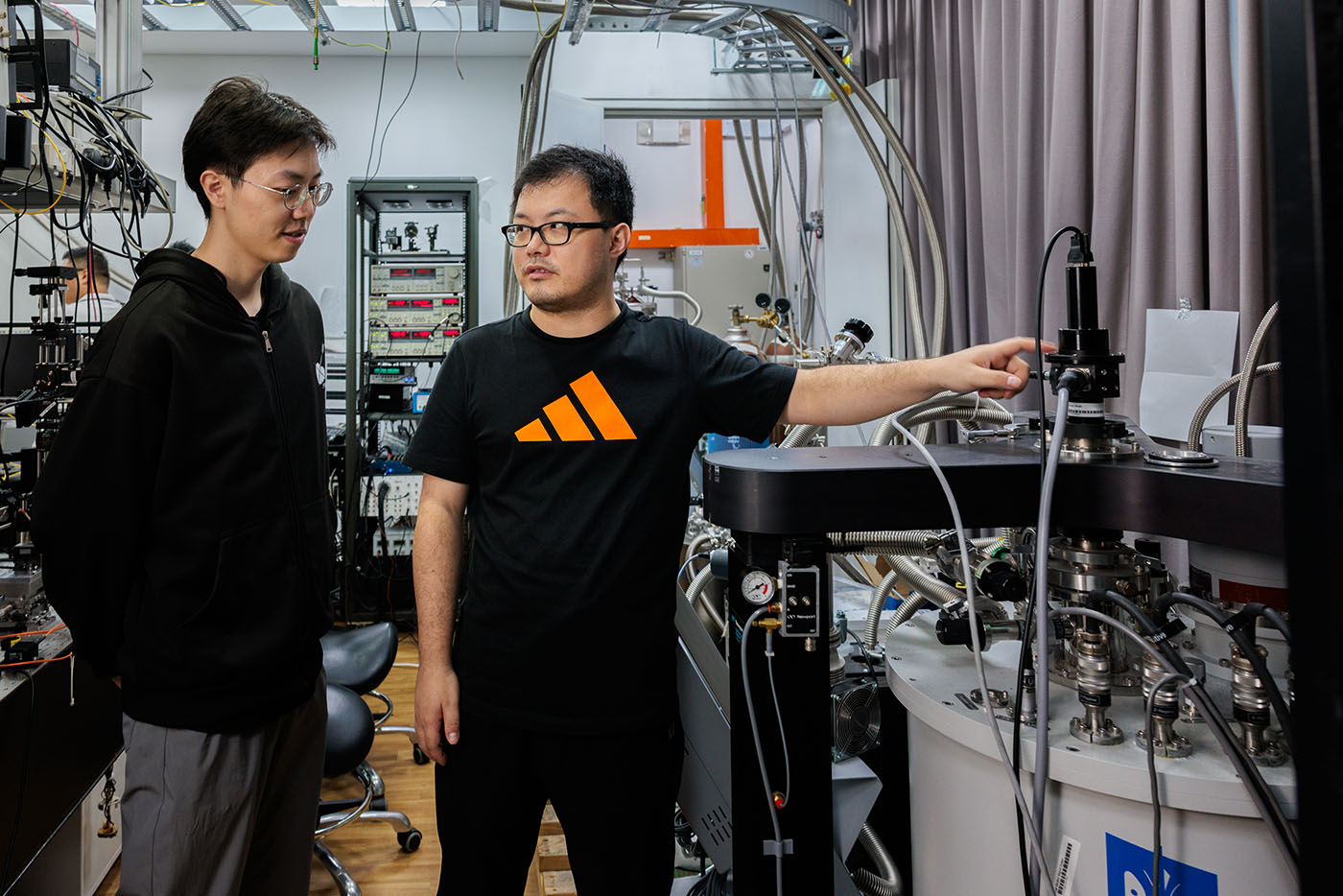Highlights
Future magnetic memory devices could rely on the quantum metric
 (From left) NTU PhD student Zhang Chusheng and NTU Senior Research Fellow Wang Naizhou are pictured with the cryogenic superconducting magnet setup used to measure devices made with flakes of MnBi2Te4.
(From left) NTU PhD student Zhang Chusheng and NTU Senior Research Fellow Wang Naizhou are pictured with the cryogenic superconducting magnet setup used to measure devices made with flakes of MnBi2Te4.
An international team of researchers led by CQT Principal Investigator Gao Weibo have discovered they can measure the ‘quantum metric’ – and in the process surface a category of materials promising for use in magnetic memories and other electronic devices. The team report their experimental results in Nature. The paper appears in the 21 September print edition after advance online publication in June.
The quantum metric is a fundamental part of the description of a quantum state. It relates to the shape, or topology, of a state. Theorists had predicted the quantum metric should give rise to some unusual properties in magnetic topological materials. Now, Weibo and his team, including collaborators in China, Israel and Japan, have become the first to demonstrate the effects by electrical transport measurement.
The researchers foresee applications. “Our discovery provides a straightforward way to read data stored in antiferromagnets by being able to distinguish the two states the materials can take,” said Weibo, in an announcement by the Nanyang Technological University, Singapore, where he is an Associate Professor. “The findings advance research in using antiferromagnets for computer memory in the future.”
Antiferromagnetic materials are attractive for designing memory devices because they are less sensitive to data corruption by external magnetic fields than materials used today.
The researchers studied the antiferromagnetic material manganese bismuth telluride, or MnBi2Te4.
Types of magnetism
The magnetism of a material comes from the electron spin of its atoms. Conventional magnetic memory devices use ferromagnetic materials, such as iron, cobalt and their alloys, where the electron spins align with neighbouring spins to point in the same direction. In antiferromagnetic materials, on the other hand, the spins of neighbouring atoms point in opposite directions.
Weibo and his team worked with crystal flakes of MnBi2Te4 just a few layers of atoms thick. When there are an even number of layers, the manganese atoms within each layer align ferromagnetically, but each layer points in the opposite direction to the layer below it. That makes the material antiferromagnetic overall.
The researchers did most of their measurements on a sheet of MnBi2Te4 four layers thick. It has two different antiferromagnetic ground states, depending on the direction the spins aligned in different layers. The spins of each layer can be aligned, eg, either “up-down-up-down” or “down-up-down-up” – and you could label these a “0” state and “1” state to store data.
Bit flips
The researchers could flip their material between the two states by applying a magnetic field. They studied how the different spin orders affected the movement of electrons through the material. The electrical transport measurements were performed in a cryogenic-free cryostat equipped with a superconducting magnet at temperatures.
When a current was injected, the researchers found that the voltage across the material scaled nonlinearly – a nonlinear anomalous Hall effect – and had a different sign in each of the two ground states. This transport phenomenon arises from the quantum metric.
Practically, the distinct voltage signals for opposite spin orders offer a solution to the problem of reading data stored in antiferromagnets. Data store in ferromagnetic materials can easily be read out from the magnetic field generated by the different alignment of the 0 and 1 states, but antiferromagnetic materials do not produce magnetic fields.
Weibo’s results show data could be read electrically: for example, a positive voltage could show MnBi2Te4 was in a state representing 0 and a negative voltage that MnBi2Te4 was in a state representing 1. These material properties could also be exploited in rectifying devices that convert AC to DC current.
The team believes that other antiferromagnets will display similar quantum metric-induced behaviours. They did their experiments at temperatures a few degrees above absolute zero. Their next step will be to look for materials that can encode data at room temperature.
Learn more
Related Stories
 | Quantum states mapped efficiently with overlapping measurements April 19 2023 |
 | Meet a CQTian: Gao Weibo July 20 2022 |






